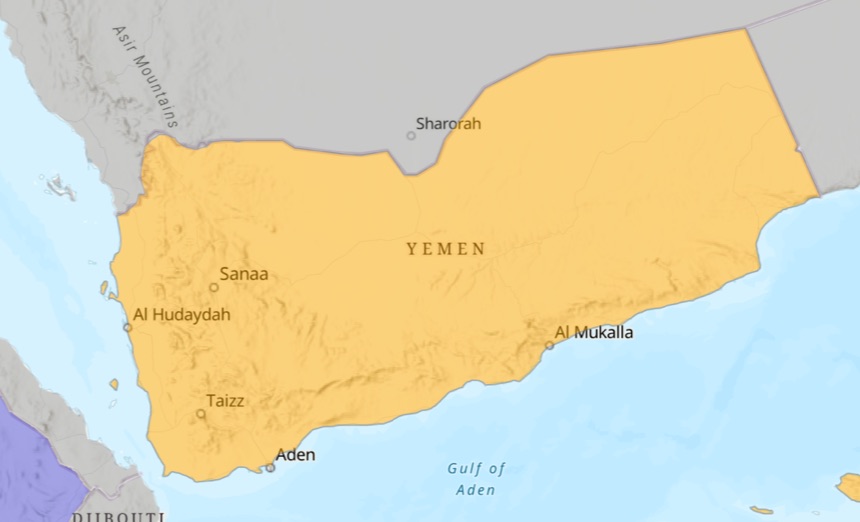Yemen has been affected by armed conflicts since the beginning of the last century. The country has experienced the struggle of the Yemeni people for liberation, the revolutions of 1962 and 1963, the civil war, and the war of separation of 1994. This long history of conflict – combined with the country’s close proximity to sources of tension in the Horn of Africa, and social structures based on tribal values that consider weapons an integral part of masculinity – play a role in the extensive proliferation of small arms and light weapons throughout the country.1 Yemen had the second-highest number of guns per capita in the world in 2017.2 The conflict between the Saudi-led coalition and Houthi rebels aligned with former president Ali Abdullah Saleh escalated in 2015 and led to a massive humanitarian crisis.3 From the beginning of the conflict, more than 20,000 civilians have been killed and wounded, and over 3.65 million people displaced. Moreover, around 24.1 million people are currently in need of humanitarian assistance.4
To address the arms issue and combat illicit trade in small arms and light weapons, Yemen passed the Law on Carrying Firearms, Ammunitions and their Trade in 1992.5 The United States has been providing assistance, with the UN Development Programme (UNDP) and the HALO Trust acting as implementing partners on programmes across Yemen focusing on explosive hazard reduction, clearance and risk education.6
1 Yemen, National Report on the Implementation of the Programme of Action on Small Arms and Light Weapons (PoA) and the International Tracing Instrument (ITI) (New York: Permanent Mission of Yemen to the UN, 2006), https://unoda-poa.s3.amazonaws.com/poa-reports-le/2010%40215%402010-PoA-National-Report-Yemen-En.doc.
2 Philip Alpers and Marcus Wilson, Yemen – Gun Facts, Figures and the Law (GunPolicy.org, Sydney School of Public Health, University of Sydney, 2022), https://www.gunpolicy.org/firearms/region/yemen.
3 “Non-international armed conflicts in Yemen,” Rule of Law in Armed Conflicts Project (RULAC), Geneva Academy of International Humanitarian Law and Human Rights, updated January 31, 2018, https://www.rulac.org/browse/conflicts/non-international-armed-conflicts-in-yemen#collapse2accord; “Yemen,” International Crisis Group, 2022, https://www.crisisgroup.org/middle-east-north-africa/gulf-and-arabian-peninsula/yemen.
4 “Yemen War: No End in Sight,” Amnesty International, March 24, 2020, https://www.amnesty.org/en/latest/news/2015/09/yemen-the-forgotten-war.
5 Alpers and Wilson, Yemen – Gun Facts, Figures and the Law.
6 Bureau of Political-Military Affairs, US Department of State, To Walk the Earth in Safety (Washington, DC: US Department of State, 2018), https://www.state.gov/wp-content/uploads/2019/04/tweis_2019.pdf.
Launch the country dashboard
Further information
Accidental explosions
Since the Small Arms Survey began collecting data in 1979, 18 accidental explosions have been reported in Yemen.
Table 1. Accidental explosions in Yemen (1979–2021)
Year | Location | Owner/manager | Deaths | Injuries |
2019 | Aden | State (N/A) | 6 | 6 |
2019 | Mocha | N/A | 6 | 7 |
2015 | Aden | State (military) | 14 | 9 |
2013 | Abs | State (military) | 10 | N/A |
2013 | Sana’a | State (military) | 0 | 0 |
2012 | Aden | State (military) | 6 | N/A |
2012 | Sana’a | Non-state (actor) | 0 | 18 |
2012 | Sana’a | Non-state (actor) | 0 | 0 |
2011 | Ja’ar | State (military) | 150 | 150 |
2011 | Sana’a | Non-state (actor) | 28 | N/A |
2010 | Taiz | Non-state (private) | 19 | 15 |
2007 | Noqum | N/A | 0 | 0 |
2007 | Sana’a | N/A | 0 | 0 |
2007 | Sana’a | N/A | N/A | N/A |
2006 | Khormaksar | State (military) | 3 | N/A |
2001 | Al-Bayda | Non-state (actor) | 14 | 50 |
1996 | Aden | State (military) | 7 | 21 |
1995 | Aden | State (military) | 10 | 0 |
Source: “Unplanned Explosions at Munitions Sites (UEMS) Database,” Small Arms Survey, updated December 15, 2021, https://smallarmssurvey.org/database/unplanned-explosions-munitions-sites-uems.
Cases of diversion
Numerous cases of diversion have been reported in Yemen.
Table 2. Cases of diversion of arms, ammunition and explosives in Yemen
Year | Location | Description |
2015–2017 | Throughout the country | Large-scale seizures have occurred from the Yemeni national stockpile, and 68% of the national stockpile has been looted since the conflict’s escalation. |
2013 | N/A | After having been dismissed as a commander of the elite unit, Ahmed Ali Saleh (the former president’s son) looted an arsenal of weapons from the Republican Guard – including thousands of M-16 rifles, dozens of Humvees, Ford vehicles, and Glock pistols. All of these have been supplied in the past to the country by the United States. |
Sources: “Pentagon Loses Track of $500 Million in Weapons, Equipment Given to Yemen,” Washington Post, March 17, 2015, https://www.washingtonpost.com/world/national-security/pentagon-loses-sight-of-500-million-in-counterterrorism-aid-given-to-yemen/2015/03/17/f4ca25ce-cbf9-11e4-8a46-b1dc9be5a8ff_story.html; "Final Report of the Panel of Experts on Yemen," UN Security Council, S/2017/81, January 31, 2017, https://www.securitycouncilreport.org/atf/cf/%7B65BFCF9B-6D27-4E9C-8CD3-CF6E4FF96FF9%7D/s_2017_81.pdf.
Disposal
In 2009, 350 tonnes of explosives and ammunition were destroyed.
Source: Yemen, National Report on the Implementation of the Programme of Action on Small Arms and Light Weapons (PoA) and the International Tracing Instrument (ITI) (New York: Permanent Mission of Yemen to the UN, 2010), https://unoda-poa.s3.amazonaws.com/poa-reports-le/2010%40215%402010-PoA-National-Report-Yemen-En.doc.
Needs
To further enhance safe and secure ammunition management, the following needs have been identified for Yemen:
- Financial assistance for the implementation of a plan to extend police security in all parts of the country;
- Training of personnel; and
- Financial support and cooperation on control over the country’s coast aimed at preventing and eradicating the illicit trade in small arms and light weapons.
Source: Yemen, National PoA Report.



